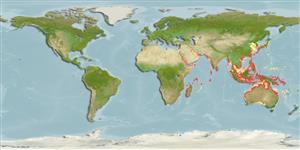Teleostei (teleosts) >
Eupercaria/misc (Various families in series Eupercaria) >
Sillaginidae (Smelt-whitings)
Etymology: Sillago: From a locality in Australia.
Environment: milieu / climate zone / depth range / distribution range
Ecology
Marine; brackish; reef-associated; amphidromous (Ref. 51243); depth range 0 - 60 m (Ref. 6205), usually 0 - 2 m (Ref. 90102). Tropical; 26°C - 29°C (Ref. 4959); 41°N - 36°S, 20°E - 166°E (Ref. 6205)
Indo-West Pacific: southern Red Sea (Ref. 94953) and Knysna, South Africa to Japan and south to Australia. Reported from New Caledonia (Ref. 9070). In Japan, this name has often been misapplied to Sillago japonica; often misidentified as Sillago lutea or Sillago vincenti.
Length at first maturity / Size / Weight / Age
Maturity: Lm 16.7, range 13 - 19.1 cm
Max length : 31.0 cm SL male/unsexed; (Ref. 44894); common length : 20.0 cm SL male/unsexed; (Ref. 9679); max. reported age: 7 years (Ref. 43081)
Dorsal spines (total): 11 - 13; Dorsal soft rays (total): 20 - 23; Anal spines: 2; Anal soft rays: 18 - 23. Swim bladder with two anterior and two posterior extensions. The anterior extensions extend forward and diverge to terminate on each side of the basioccipital above the auditory capsule. Two lateral extensions commence anteriorly, each sending a blind tubule anterolaterally and then extending along the abdominal wall below the investing peritoneum to just posterior of the duct-like process. Two posterior tapering extensions of the swim bladder project into the caudal region, one usually longer than the other. The species has a low lateral line with about 70 scales (Ref. 48635).
Common along beaches, sandbars, mangrove creeks and estuaries. Recorded from freshwater. Form schools. Adults bury themselves in the sand when disturbed (Ref. 6205, 44894). Feed mainly on polychaete worms, small prawns (Penaeus), shrimps and amphipods (Ref. 6226, 6227, 44894). Oviparous (Ref. 205). Larvae and juveniles are pelagic feeding on planktonic (Ref. 43081). Rarely captured by prawn trawling vessels. Marketed fresh and frozen (Ref. 9987).
McKay, R.J., 1992. FAO Species Catalogue. Vol. 14. Sillaginid fishes of the world (family Sillaginidae). An annotated and illustrated catalogue of the sillago, smelt or Indo-Pacific whiting species known to date. Rome: FAO. FAO Fish. Synop. 125(14):87p. (Ref. 6205)
IUCN Red List Status (Ref. 130435: Version 2024-2)
Threat to humans
Harmless
Human uses
Fisheries: commercial; aquaculture: commercial
Tools
Special reports
Download XML
Internet sources
Estimates based on models
Preferred temperature (Ref.
123201): 24.8 - 29.2, mean 28.5 °C (based on 3250 cells).
Phylogenetic diversity index (Ref.
82804): PD
50 = 0.5000 [Uniqueness, from 0.5 = low to 2.0 = high].
Bayesian length-weight: a=0.00575 (0.00480 - 0.00689), b=3.06 (3.01 - 3.11), in cm total length, based on LWR estimates for this species (Ref.
93245).
Trophic level (Ref.
69278): 3.3 ±0.1 se; based on diet studies.
Resilience (Ref.
120179): High, minimum population doubling time less than 15 months (K=0.75-1.22; tm=1; tmax=4; Fec=16,682).
Prior r = 0.79, 95% CL = 0.52 - 1.19, Based on 1 data-limited stock assessment.
Fishing Vulnerability (Ref.
59153): Low vulnerability (24 of 100).
Climate Vulnerability (Ref.
125649): Moderate vulnerability (43 of 100).
Nutrients (Ref.
124155): Calcium = 208 [37, 506] mg/100g; Iron = 0.719 [0.238, 1.909] mg/100g; Protein = 21 [18, 23] %; Omega3 = 0.0971 [, ] g/100g; Selenium = 31 [9, 139] μg/100g; VitaminA = 113 [19, 650] μg/100g; Zinc = 1.42 [0.69, 3.58] mg/100g (wet weight); based on
nutrient studies.
